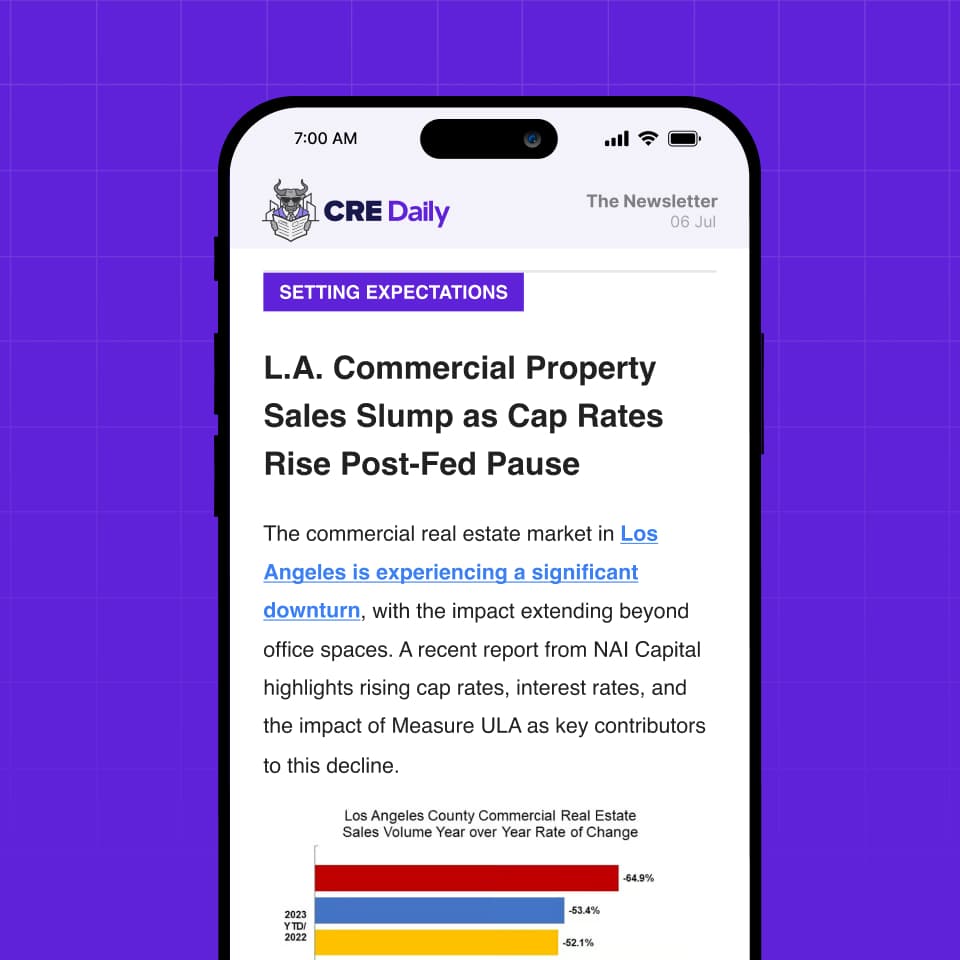- Flagstar Financial cut its multifamily loan exposure by $3.2B (9%) and office exposure by $900M (27%) in 2024.
- The bank reported a $160M net loss in Q4, down significantly from $2.7B in 4Q23.
- Delinquencies surged 270% in Q4, with loans 30–89 days past due rising from $261M to $965M.
- CRE distress remains a challenge, with $2.6B in nonaccrual loans, $1.7B tied to multifamily properties.
- Flagstar expects to be profitable again in 2026, after stabilizing its balance sheet with loan sales, cost-cutting, and branch divestitures.
Flagstar Financial (FLG), formerly New York Community Bancorp, is taking aggressive steps to reduce risk and rebuild investor confidence after nearly collapsing in early 2024, per Bisnow.
The bank, headquartered in Long Island, is offloading problematic multifamily and office loans, property types that continue to struggle nationwide.
By The Numbers
In its Q4 2024 earnings report, Flagstar announced it had cut its multifamily exposure by $3.2B (9%) and office exposure by $900M (27%) over the past year.
The move is part of a broader effort to clean up its balance sheet, which had been weighed down by rising delinquencies and falling property values in its loan portfolio.
CEO Joseph Otting, who took over in March 2024 amid a leadership shakeup, emphasized the bank is actively managing its risk through loan sales, debt payoffs, and runoff of non-relationship CRE loans.
Get Smarter about what matters in CRE
Stay ahead of trends in commercial real estate with CRE Daily – the free newsletter delivering everything you need to start your day in just 5-minutes
More Financial Losses
Despite ongoing losses, Flagstar’s Q4 report provided some encouraging signs. The bank posted a $160M net loss, a sharp improvement from its $280M loss in Q3 and a staggering $2.7B loss in 4Q23.
Additionally, provisions for credit losses fell by 55% ($124M) to $108M in Q4, an 80% decline from Q4. This indicates that while nonaccrual loans remain a problem, Flagstar is making progress in stabilizing its loan book.
Wall Street reacted positively to the earnings report, as Flagstar’s stock surged 17% following the announcement. Analysts had forecast a per-share loss of 51–56 cents, but the bank outperformed expectations, reporting a 34-cent loss per share.
CRE Loan Distress
While Flagstar has significantly cut its overall loan exposure, it’s still grappling with high levels of delinquencies and nonaccrual loans.
- Nonaccrual loans totaled $2.6B in Q4, up $101M from Q3 and $2.2B YoY.
- Multifamily accounts for $1.7B of these nonaccrual loans, revealing the sector’s struggles.
- Net charge-offs reached $222M, up 20% from Q4, but slightly down from Q3.
To further reduce its CRE exposure, Flagstar is marketing $266M in nonaccrual CRE loans for sale, including $215M in office loans and $51M in multifamily loans. This follows the sale of $5B in mortgage warehouse loans to JPMorgan Chase in 2023.
Tough Landscape For Banks
Flagstar’s real estate struggles are part of a broader trend, as the commercial mortgage-backed securities (CMBS) special servicing rate nears 10%, the highest level since late 2020, per Trepp.
- Multifamily special servicing reached 8.7% in December.
- Office distress hit 14%, the highest level since 2012 and is near 15%, not seen since 2000.
The bank’s exposure to NYC’s rent-stabilized multifamily sector is a key risk factor. More than 57% of Flagstar’s $20.4B multifamily loan portfolio is tied to NY State, where restrictive 2019 rent control laws have severely impacted property values and cash flow.
In 2023, the SEC requested more transparency from Flagstar and other banks regarding their exposure to rent-stabilized assets. As rising expenses and limited rent growth pressure landlords, defaults have shot up.
Back in Business?
After a turbulent year, Flagstar executives believe the bank is now positioned for a strong recovery. CFO Lee Smith emphasized recent property appraisals have not been as bad as expected, suggesting asset values may be stabilizing.
While delinquencies jumped 270% in Q4, Flagstar noted that this was largely due to one unnamed borrower. Without that case, delinquencies would have risen from $261M to $425M, rather than $965M.
In March 2024, the bank avoided collapse through a $1B equity infusion, led by former Treasury Secretary Steven Mnuchin. With $31.8B in liquidity and a 240% coverage ratio, Flagstar executives are confident in the bank’s ability to weather ongoing economic challenges.
The bank now expects to return to profitability by 2026, after fully restructuring its loan portfolio and strengthening its balance sheet.
“We think the company is very uniquely positioned now as a strong regional bank,” CEO Joseph Otting said. “America needs a strong regional bank.”
















